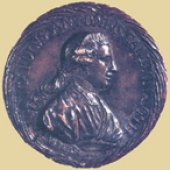He was born in Lunèville (Meurthe-et-Moselle) in Lorraine, from Jacques Champion and Charlotte Bruget. Although we have little information about the first period of his training, we know that at the Lorraine Court in that period all the musical activities were directed by the French composer Henry Desmarets. Probably the move of the Champion family was contemporary to the raising of Francesco Stefano of Lorraine to the Grand Duchy of Tuscany (1737), because Charles-Antoine’s father worked at that Court. And it is also likely that Champion studied with Giuseppe Tartini or at least with someone from the school of Padova. He was the Chapel Master of the Livorno Cathedral from 1752 to 1762, and then - from February 14th 1763 till his death - he hold the same office in the cathedral of Santa Maria del Fiore and in the oratory of San Giovanni Battista at the Court of Florence. Between 1761 and 1762 Champion stayed in Paris to supervise some of his works: a reprint of the opera 2 - 6 sonata for two violins and thorough bass - the sonata for harpsichord op.4, and a Salve Regina - which is the only sacred music he ever published. Many works of Champion - especially the sonata a tre - were published in London by the publisher Walsch. The Parisian reprint follow a system of numbering the opera which is different from the English edition, that are probably the respectful of the original order chosen by Champion. These English editions were very largely distributed and reached the American colony, where the young Thomas Jefferson - who was an amateur violinist - became an appreciator of Champion and began to collect all his works for violin. Jefferson himself made a thematic catalogue which has been very useful to give order to the print production of Champion. In 1766 he married Margherita Perloz Brunet, musician and a painter who was Florentine but with French origin. In 1770 he met the fourteen year old Mozart in Florence, and played with him and Pietro Nardini, who was the director of music at the ducal Court. In the same year he met Charles Burney, an English music historiographer who collected material in Italy for his book "The present state of music in France and Italy". Burney was impressed by the big collection of ancient music - consisting mainly in madrigals of the seventeenth and eighteenth century - possessed by Champion. And the passion of Champion for the ancient music and the treatises of musical theory is confirmed by the correspondence he had with Father Martini. Champion asked Father Martini for compositions and texts as the Dialogo della musica antica e moderna [Dialogue of ancient and modern music] by Vincenzo Galilei, the Thoscanello della musica by Pietro Aaron and the Arte del contrappunto [Art of Counterpoint] by Giovanni Maria Artusi. From 1770 till his death we have little information of his activities and biographical events. Champion is an important personality for the period of transition towards the stylistic features and taste of classicism. His link with the past is clear in the genre of the sonata a tre - a genre he loved but was not so popular among his contemporaries - where he shows a strong taste for the counterpoint. However his writing for violin is often original and has rich technical innovations and follows the school of Tartini. The structure of the sonata is tripartite: Adagio - imitative or singable - Allegro - fugato or in a sonata form - and Allegro - dance time or Rondo. The central time, which is the largest and more elaborate time, often presents a mature exemplification of the tripartite sonata form with exposition, development and repeat. The sonatas of opera 5 and 6 give a more important role to the first violin and present an use of the harmony which is more interesting, more "modern" and chromatic. The sonatas for harpsichord too reveal a writing which is graceful, and sometimes technically bold. The main part of Champion’s sacred music production - most of all Requiem, Offertories and Responsories - , which is characterized by a severe and austere contrapuntist style, was written and performed for the Court of the Grand Duchy of Tuscany. Particularly, the Te Deum which was written for the birth of the heir Francesco Giuseppe in 1768, and was praised by Burney, provided for 200 players - instrumentalists and singers. The dramatic composition Venere placata - based on a libretto by M.Coltellini and performed in 1760 for the marriage of the archduke Giuseppe with Isabel of the Borboun - and the cantata T’amo bell’idol mio are the only compositions left of his profane vocal production. The Trattato teorico e pratico dell’accompagnamento del cimbalo con l’arte di trasportare in tutti i toni e sopra tutti gli strumenti [Theoretic and practical treatise on the cymbal accompanying with the art of transpose in all the tunes and above all the instruments], which we have in an autograph manuscript, was never published.
Air Jordan For Sale Cheap,Air Jordan Retro 9 Preschool Air Jordan Retro 9 Johnny Kilroy,air Jordan Retro 9 Johnny Kilroy For Sale,air Jordan 9 Retro Johnny Kilroy Joe Aj9 Black Silver Basketball-shoes 302370-012
Instrumental music
Concerto in Do Magg. per flauto e orchestra
Concerto in Re Magg. per flauto e orchestra
Concerto in Sol Magg. per flauto e orchestra
Concerto in Sol Magg. per due flauti e orchestra
Chamber music
8 Sonate da Camera op. IX
3 Sonate da Camera per flauto e B. C.










